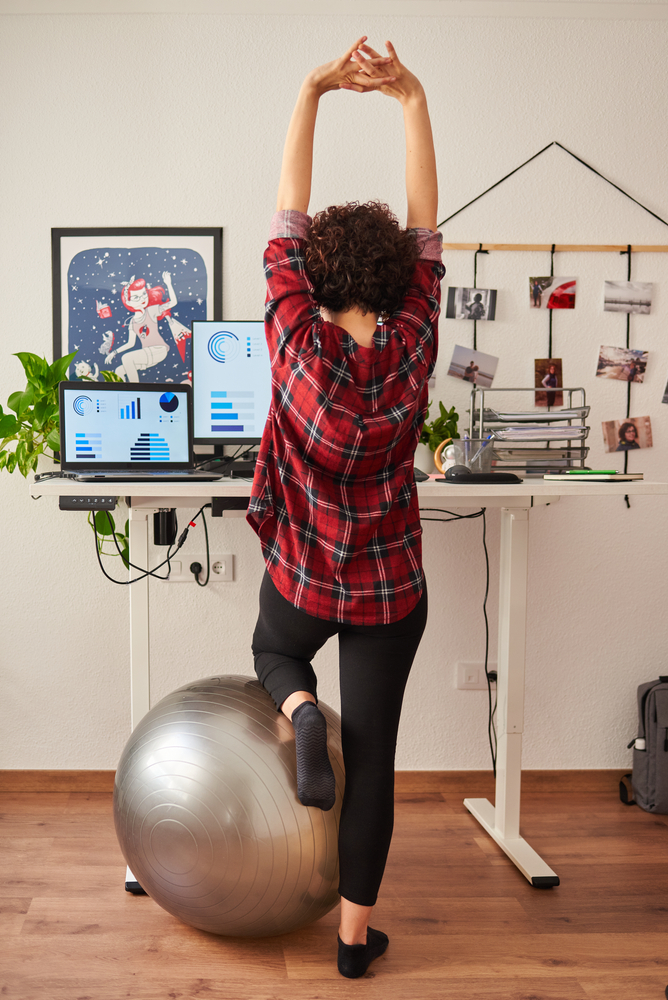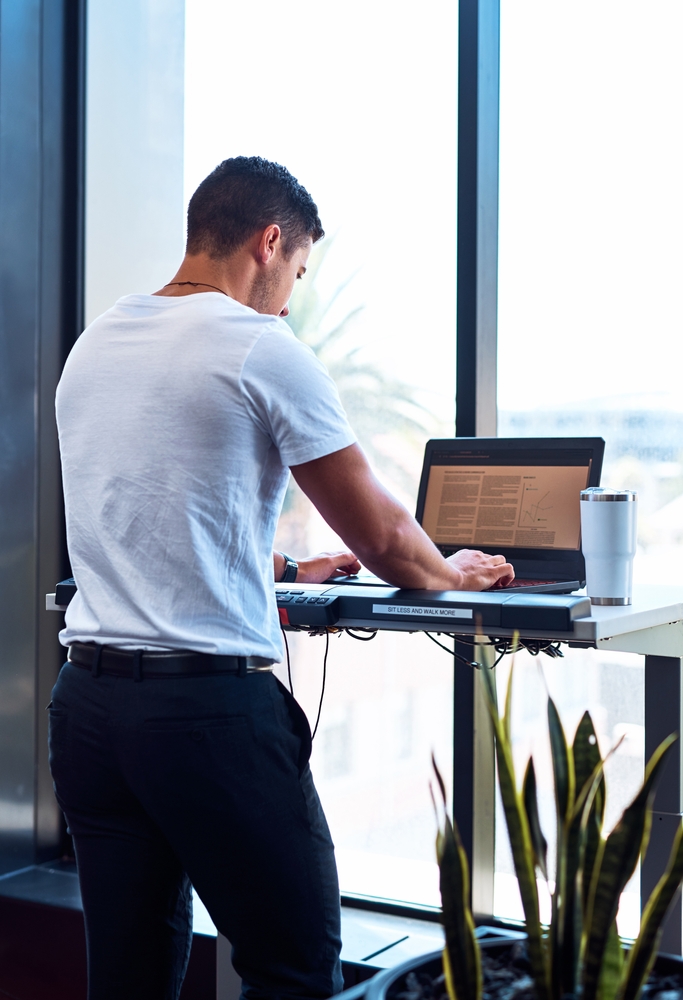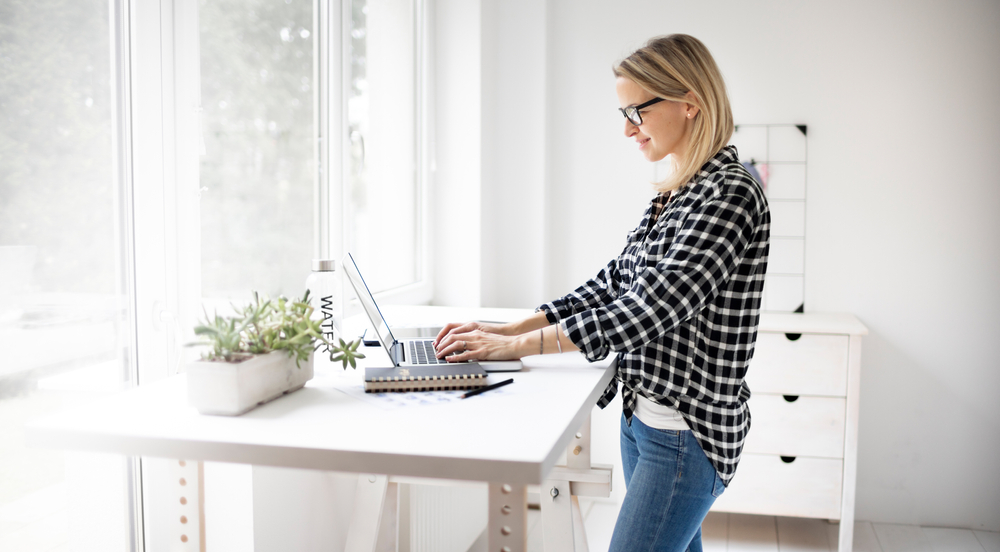Why a Standing Desk is a Game-Changer for Your Home Office
As a remote worker, you’re aware that you likely spend less time moving than the average person, and are likely aware of the negative effects that prolonged sitting can have on your health and well-being. From back pain to poor posture, sitting for extended periods can take a toll on your body and mind. That’s where a standing desk comes in – it offers a solution to the problem of prolonged sitting, providing numerous benefits for your health, productivity, and overall well-being. In this article, we will explore the reasons why if you work from home a standing desk can be not only a worthy investment, but a game-changer. We have recommendations for transition from a sitting to standing desk, our favorite standing desks and accessories, and the best Haymaker spaces for trying out a standing desk.
Benefits of a Standing Desk
Enhanced Focus
By breaking up the monotony of sitting for hours at a time, a standing desk can help improve focus, reduce boredom, and increase motivation. This can be especially helpful for people who struggle to stay focused and motivated when sitting for extended periods.
Increased Energy
Another benefit of using a standing desk is increased energy levels. By standing and moving throughout the day, you can improve mood, reduce feelings of fatigue, and increase motivation. This can help you be more productive and focused, enabling you to get more done in less time.
Better Posture
One of the most common problems associated with prolonged sitting is poor posture. By using a standing desk, you can reduce the amount of time you spend slouching or hunching over a computer, helping to improve posture and reduce the risk of back and neck pain.
Increased Creativity
Finally, a standing desk can help stimulate creativity and encourage new ideas. By breaking up the routine of sitting at a desk, it can help inspire new ideas and provide a fresh perspective on projects and tasks.
Transitioning from Sitting To Standing
It is important to make sure you are using your standing desk properly and making the transition gradually, as standing for extended periods can take some getting used to. Here are some steps you can take to plan for the transition:
Start Slowly
Begin by standing for short periods of time, gradually increasing the amount of time you spend standing over several days or weeks. This will help your body adjust to the new position and prevent discomfort.
Consider a Standing Desk Converter
If you’re not ready to invest in a full standing desk, consider using a standing desk converter to raise your existing desk to a standing height. This will allow you to test out standing while you work before committing to a full standing desk.
Choose the Right Height
The height of your desk is important for proper ergonomic alignment. Your elbows should be at a 90-degree angle when typing, and your computer screen should be at eye level. Adjust your desk to the appropriate height for your body.
Wear Comfortable Shoes
Standing for long periods of time can put a strain on your feet, so it’s important to wear comfortable shoes with good support.
Use an Anti-fatigue Mat
An anti-fatigue mat can help reduce strain on your feet, legs, and back by providing cushioning and support.
Take Breaks
Just like when sitting, it’s important to take breaks and move around when standing. Take short breaks to stretch, walk around, or sit down to rest your feet and legs.


Types of Standing Desks
When choosing a standing desk, it is important to find one that is comfortable, adjustable, and fits your needs and budget. There are many options available, from manual adjustable desks to electric desks, so you can find the one that works best for you. You can invest in an anti-fatigue mat to ensure that your feet and legs are comfortable, especially if you have hardwood or concrete floors.
Fixed-height standing desks: These are standing desks that have a fixed height, and cannot be adjusted. They are typically less expensive than other types of standing desks, but may not be suitable for everyone, as you would need to find a height to meet your specific needs.
Manual standing desks: These desks are adjustable, but you have to manually adjust the height by turning a crank or using a handle. These can be a good option if you don’t mind putting in a little bit of effort to adjust your desk.
Electric standing desks: These are standing desks that are adjusted electronically with the push of a button. They tend to be more expensive than manual standing desks, but are more convenient to adjust.
Desktop converters: These are devices that sit on top of your existing desk and raise your computer and other items to a standing height. They are less expensive than full standing desks, but may not be as sturdy or adjustable.
Treadmill desks: These are standing desks with a built-in treadmill, allowing you to walk while you work. They can be a good option for people who want to get more exercise during the day, but may not be suitable for all work tasks. They are also the most expensive investment since you are essentially purchasing a treadmill as well.
Standing Desk Recommendations from the Haymaker Team
We’ve gathered a list of our team’s favorite standing desks. We may earn a small commission if you purchase using these links – thank you for your support!

Looking for meeting space, office space, flexible on-demand work space, or a place for your next work or offsite event? Search for the perfect space for you at haymakerspace.com.


